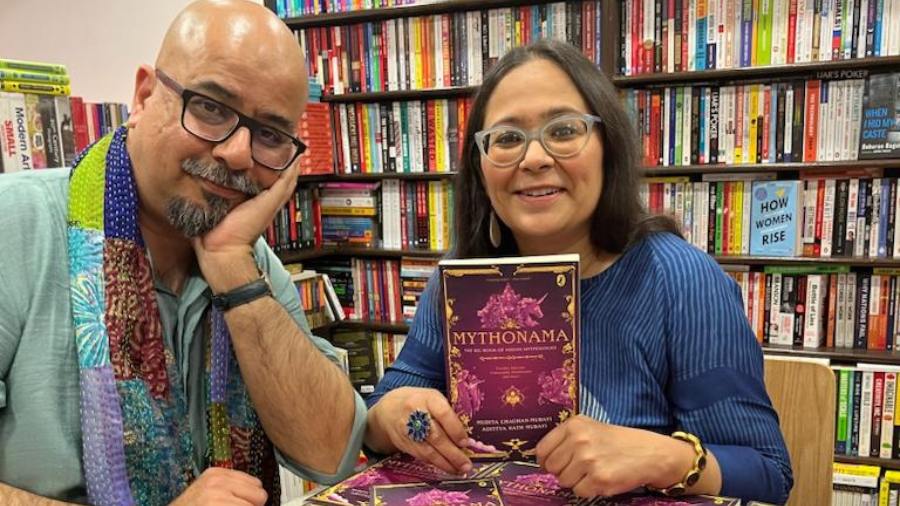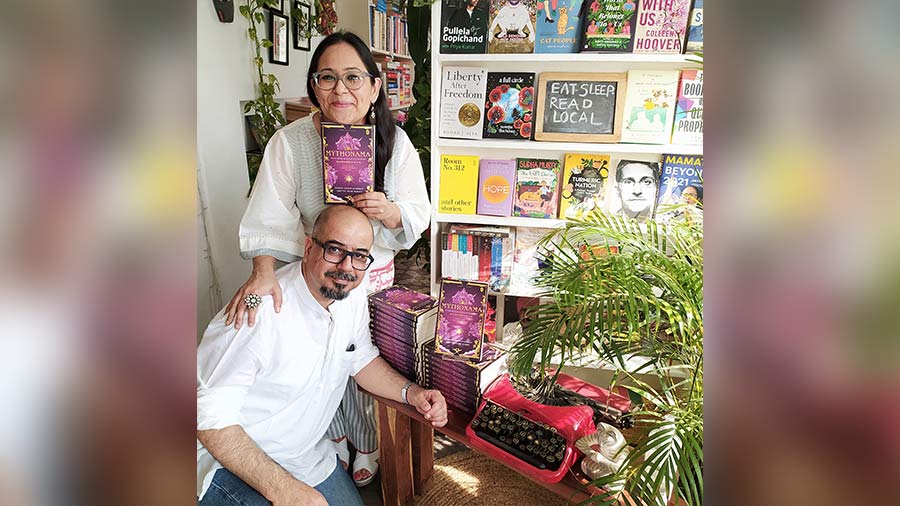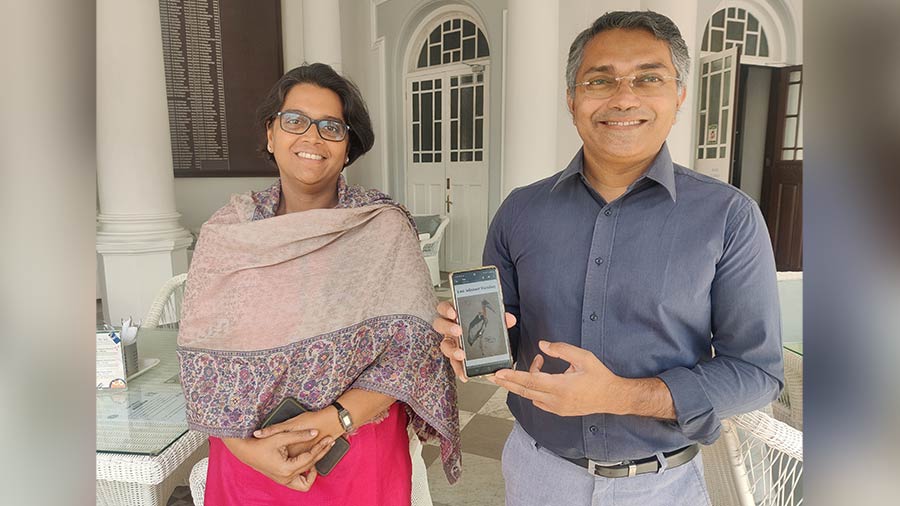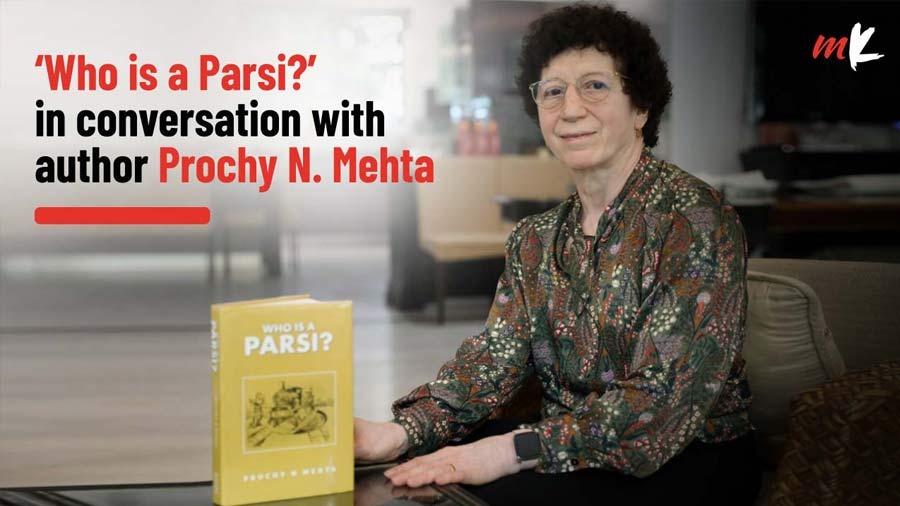Mythology is a world that provides insights into every culture. While popular culture reduces the conversation around mythology to just one or two prominent faiths, every culture has its own rich mythological literature, which captures its learnings and perspectives through engaging stories. Delhi-based author couple Mudita Chauhan-Mubayi and Adittya Nath Mubayi decided to break down the diversity in mythologies in their book Mythonama, in an effort to make it more accessible to young readers and to inculcate a need to engage with the text on a deeper level.
My Kolkata caught up with the couple, who were in the city for a few book sessions, to talk about how they see their book shaping discourse around stories of faith.
A marriage of creation
Mudita and Adittya first met at a cinema in a ‘typical boy-meets-girl situation’ in the ‘90s. “It wasn’t a mythological film, we went to watch Bombay Boys,” laughs Mudita. While Adittya was an architect by education and had worked in quizzing with Siddhartha Basu, Mudita had a journalism and research background. “Like today’s kids chat on WhatsApp, we would ask each other strange questions over email. We liked the same things, and were inquisitive about the world, so we instantly hit it off,” she says.
The duo got married and started a knowledge company specialising in quizzes in 2001. Since then, they have written a few textbooks and quiz books together. The idea for Mythonama came from a desire to elevate conversations about faith among kids, while broadening their knowledge. “We were always in an atmosphere of questions and perspectives. We wanted to expand the area of awareness for young readers and expose them to a multiverse of mythologies. This book is a personification of our desire to make mythology more secular and approachable for the common person,” explains Adittya.
Secularism in mythology
In their quest for diversity, the couple have incorporated stories from multiple faiths, including Hinduism, Islam, Christianity, Sikhism and Zoroastrianism. They have also highlighted themes based on these tales to encourage readers to draw their own learnings and have a healthy discourse.
The book takes popular mythological stories and sets them against modern, more relatable contexts and subjects. Krishna’s Navagunjara avatar, which is made of nine different animals, and how it reflects on eco-sensitivity and sustainability; Chinvat Peretu or Bridge of the Requiter in Zoroastrian legends and its similarity to Artificial Intelligence and Machine Learning; the merger of Hindu and Islamic iconography to create Sikhism by Guru Nanak and its roots in Sufi syncretism; Sita’s trial by fire and subsequent banishment having the same impact as today’s fake news and patriarchy; and the feminism in the story of Lilith the first woman in Christianity, created from the same soil as Adam but cast out for refusing to be subservient to the man.
They believe blending these well-known stories with complex modern themes provide the best structure to help kids approach larger philosophical questions.
“The book itself is very interactive. It brings gods and mythological figures to a level where readers can relate to why they did what they did. It is a culmination of our discussions about religion with modern language, our concern for the fabric of society, and our need to get children to not just read, but also engage,” Mudita summarises. Adittya adds that while writing, one of the main ideas was, “To remove the god from the temple and religiosity from mythology, making it something people can talk about, enjoy, have fun with and relate to.” He argues that the ritualism and mystery that often cloak the gods are brought in to suit people’s vested interests and inclusivity is the need of the hour. “Even Krishna played pranks, it is time we take things a little lightly. Many gods and demons are interchangeable across cultures. In Sanatan Dharma, the Devs are good and Asuras are bad. But in the northwest (of India), Parsis consider the Ahuras to be good spirits and Daevas to be evil. There is a complete transformation the moment you switch perspectives!” Mudita feels that the reason mythology has the biggest appeal is because of how it has been condensed into a part of our daily lives.
Finding the right tone
Their take comes from their own experiences with religion. While Adittya grew up in a family where faith was more important than religion, Mudita found more joy in spirituality, and had the space to take ideas from everywhere without being overpowered. Incidentally, both had the room to draw inspiration from someone’s positive attributes without worshipping them on a pedestal. The focus was on intrinsic faith.
But interpreting mythological stories can be both a beautiful and challenging task. “There is a lot for us to interpret. Depending on geography and history, mythology is interpreted over and over again. What’s happening around you and what you’re taking from it determines whether Ravana is the villain in your Ramayana, or the father of Sita in it,” Adittya points out. He also discusses the challenges of adapting tribal folklore due to its vast and language-focused nature, but emphasises on its relevance in the context of festivals. “Geography can have global ramifications as seen in the case of The Western Wall, known in the West as the Wailing Wall and the Buraq Wall in Islam.”
But the goal is never to excite or invite tension. “There are complex issues with every faith, but we haven’t dwelled on it much. While we don’t want to politicise the issue, we have left hints for readers to step back and ponder whether the god’s actions could be considered right today, or even back then. These questions are brought up throughout the book,” Mudita says. In their own words, the book is meant to be “a sounding board-cum-diary-cum-reference book that helps people live the mythology”.
In keeping with this vision, the book opens with creation stories across mythologies, asking children to think about the physics of the Big Bang Theory and the way the cosmos has emerged according to science. But much of the writing is inspired by their conversations with their own daughters, who were teenagers at the time of writing. “Our elder daughter is in college and the younger one in grade IX. We didn’t want the language to be preachy or sound silly in today’s lingo, and they provided a filter between going over-the-top and being boring. With their help, we have tried to make it comfortable to read for adolescents, while making sure they understand what we are trying to say, while also questioning what we have written,” adds Mudita.

Much of the writing in 'Mythonama' is inspired by the couple's conversations with their own daughters
Courtesy Mudita Chauhan-MubayiAdittya concludes by stating that the current climate of division and unrest is largely due to lack of awareness. “Conflict arises from ignorance because we don’t know why another faith follows a practice, especially if it runs parallel to ours. Fear of the unknown leads to feud. We want people to know more not just about their religion but also about each other’s faith. We grow by acknowledging and understanding each other’s differences. That is the only way to peace.”








